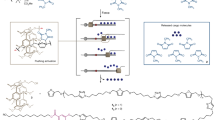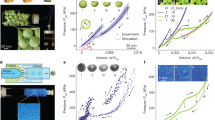Abstract
Fluorescent microbeads are emerging as optical probes for biological applications. However, insoluble crosslinked microbeads are difficult to synthesize. The existing methodology, in which polymerization occurs within dispersed micelles, is only applicable to a limited number of polymeric compounds. Herein, we report the hydrothermal synthesis of insoluble fluorescent microbeads. The newly designed and synthesized fluorenylamine-based polymers contained two styryl groups and self-assembled into spherical microparticles upon emulsification. In contrast to microparticles heated under atmospheric conditions, the microparticles became insoluble upon hydrothermal treatment and maintained their spherical morphology. Microparticles that contained a mixture of the thermosetting polymer with polystyrene resulted in an enhanced fluorescence quantum yield and a fluorescence color that could be adjusted by the mixing ratio from red to green and blue.
This is a preview of subscription content, access via your institution
Access options
Subscribe to this journal
Receive 12 print issues and online access
$259.00 per year
only $21.58 per issue
Buy this article
- Purchase on Springer Link
- Instant access to full article PDF
Prices may be subject to local taxes which are calculated during checkout




Similar content being viewed by others
References
Lassailly F, Griessinger E, Bonnet D. “Microenvironmental contaminations” induced by fluorescent lipophilic dyes used for noninvasive in vitro and in vivo cell tracking. Blood. 2010;115:5347–54. https://doi.org/10.1182/blood-2009-05-224030.
Crawford JM, Braunwald NS. Toxicity in vital fluorescence microscopy: effect of dimethylsulfoxide, rhodamine-123, and DiI-low density lipoprotein on fibroblast growth in vitro. Vitr Cell Dev Biol. 1991;27A:633–8. https://doi.org/10.1007/BF02631106.
Fei X, Gu Y. Progress in modifications and applications of fluorescent dye probe. Prog Nat Sci. 2009;19:1–7. https://doi.org/10.1016/j.pnsc.2008.06.004.
Alford R, Simpson HM, Duberman J, Hill GC, Ogawa M, Regino C, et al. Toxicity of organic fluorophores used in molecular imaging: literature review. Mol Imaging. 2009;8:341–54. https://doi.org/10.2310/7290.2009.00031.
Kobayashi H, Ogawa M, Alford R, Choyke PL, Urano Y. New strategies for fluorescent probe design in medical diagnostic imaging. Chem Rev. 2010;110:2620–40. https://doi.org/10.1021/cr900263j.
Sánchez-Martín RM, Alexander L, Bradley M. Multifunctionalized biocompatible microspheres for sensing. Ann N Y Acad Sci. 2008;1130:207–17. https://doi.org/10.1196/annals.1430.004.
Asakura R, Kusayama I, Saito D, Isobe T, Kurokawa K, Hirayama Y, et al. Preparation of fluorescent poly(methyl methacrylate) beads hybridized with Y3Al5O12:Ce3+nanophosphor for biological application. Jpn J Appl Phys. 2007;46:5193–5. https://doi.org/10.1143/JJAP.46.5193.
Nika L, Gibson T, Konkus R, Karp X. Fluorescent beads are a versatile tool for staging caenorhabditis elegans in different life histories. G3. 2016;6:1923–33. https://doi.org/10.1534/g3.116.030163.
Zhang J, Shikha S, Mei Q, Liu J, Zhang Y. Fluorescent microbeads for point-of-care testing: a review. Microchim Acta. 2019;186:361 https://doi.org/10.1007/s00604-019-3449-y.
Chern CS. Emulsion polymerization mechanisms and kinetics. Prog Polym Sci. 2006;31:443–86. https://doi.org/10.1016/j.progpolymsci.2006.02.001.
Palaniappan S, John A. Polyaniline materials by emulsion polymerization pathway. Prog Polym Sci. 2008;33:732–58. https://doi.org/10.1016/j.progpolymsci.2008.02.002.
Lovell PA, Schork FJ. Fundamentals of emulsion polymerization. Biomacromolecules. 2020;21:4396–441. https://doi.org/10.1021/acs.biomac.0c00769.
Waters H, Kettle J, Chang SW, Su CJ, Wu WR, Jeng US, et al. Organic photovoltaics based on a crosslinkable PCPDTBT analogue; synthesis, morphological studies, solar cell performance and enhanced lifetime. J Mater Chem A. 2013;1:7370–78. https://doi.org/10.1039/C3TA11002H.
Obora Y. Recent advances in the synthesis of N-alkenyl carbazoles. Tetrahedron Lett. 2018;59:167–72. https://doi.org/10.1016/j.tetlet.2017.12.020.
Chen SH. On the Stille vinylation reactions with α-styryltrimethyltin. Tetrahedron Lett. 1997;38:4741–4. https://doi.org/10.1016/S0040-4039(97)01026-5.
Su WF, Chen RT, Chen Y. Thermally crosslinkable hole-transporting poly(fluorene-co-triphenylamine) for multilayer polymer light-emitting diodes. J Polym Sci A Polym Chem. 2011;49:352–60. https://doi.org/10.1002/pola.24432.
Hung WY, Lin CY, Cheng TL, Yang SW, Chaskar A, Fan GL, et al. A new thermally crosslinkable hole injection material for OLEDs. Org Electron. 2012;13:2508–15. https://doi.org/10.1016/j.orgel.2012.06.023.
Shurdha E, Miller HA, Johnson RE, Balaich GJ, Iacono ST. Synthesis and thermal properties of a new styryl-functionalized pentafulvene glassy carbon precursor. Tetrahedron. 2014;70:5142–7. https://doi.org/10.1016/j.tet.2014.05.109.
Schneider HA. Glass transition behaviour of compatible polymer blends. Polymer. 1989;30:771–9. https://doi.org/10.1016/0032-3861(89)90172-9.
Forrest JA, Dalnoki-Veress K. The glass transition in thin polymer films. Adv Colloid Interface Sci. 2001;94:167–96. https://doi.org/10.1016/S0001-8686(01)00060-4.
Binder K, Baschnagel J, Paul W. Glass transition of polymer melts: test of theoretical concepts by computer simulation. Prog Polym Sci. 2003;28:115–72. https://doi.org/10.1016/S0079-6700(02)00030-8.
Müller C. On the glass transition of polymer semiconductors and its impact on polymer solar cell stability. Chem Mat. 2015;27:2740–54. https://doi.org/10.1021/acs.chemmater.5b00024.
Napolitano S, Glynos E, Tito NB. Glass transition of polymers in bulk, confined geometries, and near interfaces. Rep. Prog Phys. 2017;80:036602 https://doi.org/10.1088/1361-6633/aa5284.
Fukuhara T, Shibasaki Y, Ando S, Ueda M. Synthesis of thermosetting poly(phenylene ether) containing allyl groups. Polymer. 2004;45:843–7. https://doi.org/10.1016/j.polymer.2003.11.025.
Miyanishi S, Tajima K, Hashimoto K. Morphological stabilization of polymer photovoltaic cells by using cross-linkable poly(3-(5-hexenyl)thiophene). Macromolecules. 2009;42:1610–8. https://doi.org/10.1021/ma802839a.
Qiagedeer A, Yamagishi H, Hayashi S, Yamamoto Y. Polymer optical microcavity sensor for volatile organic compounds with distinct selectivity toward aromatic hydrocarbons. ACS Omega. 2021;6:21066–70. https://doi.org/10.1021/acsomega.1c02749.
Kushida S, Okada D, Sasaki F, Lin ZH, Huang JS, Yamamoto Y. Low-threshold whispering gallery mode lasing from self-assembled microspheres of single-sort conjugated polymers. Adv Opt Mater. 2017;5:1700123 https://doi.org/10.1002/adom.201700123.
Landfester K, Montenegro R, Scherf U, Güntner R, Asawapirom U, Patil S. et al. Semiconducting polymer nanospheres in aqueous dispersion prepared by a miniemulsion process. Adv Mater. 2002;14:651–5. https://doi.org/10.1002/1521-4095(20020503)14:9<651::AID-ADMA651>3.0.CO;2-V.
Yamamoto Y. Spherical resonators from π-conjugated polymers. Polym J. 2016;48:1045–50. https://doi.org/10.1038/pj.2016.81.
Oraevsky AN. Whispering-gallery waves. Quantum Electron. 2002;32:377–400.
Aikyo Y, Kushida S, Braam D, Kuwabara J, Kondo T, Kanbara T, et al. Enwrapping conjugated polymer microspheres with graphene oxide nanosheets. Chem Lett. 2016;45:1024–6. https://doi.org/10.1246/cl.160504.
Franken LE, Wei Y, Chen J, Boekema EJ, Zhao D, Stuart MCA, et al. Solvent mixing to induce molecular motor aggregation into bowl-shaped particles: underlying mechanism, particle nature, and application to control motor behavior. J Am Chem Soc. 2018;140:7860–8. https://doi.org/10.1021/jacs.8b03045.
Li M, An X, Jiang M, Li S, Liu S, Chen Z, et al. “Cellulose spacer” strategy: anti-aggregation-caused quenching membrane for mercury ion detection and removal. ACS Sustain Chem Eng. 2019;7:15182–9. https://doi.org/10.1021/acssuschemeng.9b01928.
Huang Y, Xing J, Gong Q, Chen LC, Liu G, Yao C, et al. Reducing aggregation caused quenching effect through co-assembly of PAH chromophores and molecular barriers. Nat Commun. 2019;10:169 https://doi.org/10.1038/s41467-018-08092-y.
Wyman C, Sloan PP, Shirley P. Simple analytic approximations to the CIE XYZ color matching functions. J Comput Graph Tech.2013;2:1–11. http://jcgt.org/published/0002/02/01/.
Acknowledgements
This work was supported by CREST (JPMJCR20T4) and ACT-X (JPMJAX201J) from the Japan Science and Technology Agency (JST), and by Scientific Research (A) (JP16H02081), and Young Scientist (JP22K14656) from the Japan Society for the Promotion of Science (JSPS), Ogasawara Foundation, Ministry of Science and Technology Taiwan (110-2221-E-007-006-MY3 and 110-2113-M-007-013-MY3).
Author information
Authors and Affiliations
Contributions
HY, MH and YY conceived the idea and designed the experiments; CL, C-HJ, M-CT and MH conducted the organic synthesis; YI and HY conducted the self-assembly; and HY, MH, and YY prepared the manuscript.
Corresponding authors
Ethics declarations
Conflict of interest
The authors declare no competing interests.
Additional information
Publisher’s note Springer Nature remains neutral with regard to jurisdictional claims in published maps and institutional affiliations.
Supplementary information
Rights and permissions
About this article
Cite this article
Ihara, Y., Yamagishi, H., Lin, C. et al. Hydrothermal crosslinking of poly(fluorenylamine) with styryl side chains to produce insoluble fluorescent microparticles. Polym J 55, 547–553 (2023). https://doi.org/10.1038/s41428-022-00679-z
Received:
Revised:
Accepted:
Published:
Issue Date:
DOI: https://doi.org/10.1038/s41428-022-00679-z



